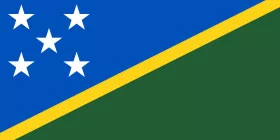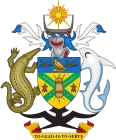Solomon Islands

Geographical Location of the Solomon Islands
The Solomon Islands are made up of almost a thousand islands, many of which are small coral islands and atolls, but the main islands are eight larger volcanic islands that form two parallel chains. The southernmost of the Solomon Islands is Rennell Island, the world's largest coral atoll. The largest of the main islands is called Guadalcanal, and the most populous is Malaita. Some of the islands have mountains, and the highest mountain is located on Guadalcanal and has a height of 2335 meters. The climate is tropical - hot and humid all year round.
The largest islands still have rainforests, but in many places the forest has been removed and replaced with a grassy, savanna-like landscape. In 2007, an undersea earthquake measuring 8.1 on the Richter scale caused a tsunami that caused enormous destruction. 34 people died and almost 10,000 were left homeless.
Rainforests in the Solomon Islands are being cut down at too rapid a rate, leading to soil erosion. Additionally, many of the coral reefs surrounding the islands are dead or dying. The islands are highly susceptible to natural disasters such as tsunamis and earthquakes, as well as extreme weather conditions, which are exacerbated by climate change.
Brief History of the Solomon Islands
The first immigration to the Solomon Islands probably occurred in 4000 BC. The first European to arrive here was the Spanish navigator Alvaro de Mendaña de Neira in 1568. He named the islands after the biblical King Solomon. It took 200 years before Europeans visited them again.
In the 1850s, the Church of England began conducting missions in the islands, and at the same time, brutal recruitment began on plantations in Australia. In 1888, Britain and Germany took control of every part of the islands. In 1893, Germany ceded most of its islands to Great Britain, which established a British protectorate.
The Solomon Islands were heavily fought during World War II, but returned to Allied control in 1944. The war inspired the nationalist movement and demands for independence. On July 7, 1978, the Solomon Islands became an independent state, but remained a member of what is now the Commonwealth of Nations.
The political situation in the Solomon Islands was previously unstable. Conflicts between ethnic groups have previously led to civil wars. In the early 2000s, the Solomon Islands received assistance from a multinational force to restore peace and order. The violence claimed several hundred lives and forced 20,000 people to flee. In 2017, the multinational force returned home.
Society and Politics of Solomon Islands
Solomon Islands is a constitutional monarchy and part of the Commonwealth of Nations, with the British Queen as its head of state. It is represented by the Governor-General, elected by the National Assembly of the Solomon Islands. The Prime Minister is elected by the National Assembly and proposes members of the government, who are then appointed by the Governor General. The country does not have its own defense, but Australia has promised to help the country in case of unrest.
Corruption is a serious problem, but the situation has improved since 2017, when a newly formed investigative team uncovered corruption among leading politicians. Violence against women is widespread and the island nation lacks laws to curb violence.
Economy and Trade of Solomon Islands
Nine out of ten people in the country earn their living from farming or fishing for their own needs. The service sector employs the majority of the active workforce and accounted for nearly half of the country's GDP in the early 2000s. Tourism has grown but is not an important part of the economy.
The Solomon Islands' most important resources and exports, including fish and timber, were overloaded and therefore resources dwindled. The country attracted international attention in 2004 when logging companies deforested several islands in a matter of weeks. After this, politicians came under severe criticism for bribes and corruption. Other important exports are agricultural products such as cocoa and palm oil. Important imported goods are machinery, fuel, industrial goods and food. The Solomon Islands' most important trading partners are China, Australia and other Asian countries.
The transition from a subsistence and barter economy to a modern monetary economy is moving slowly. Economic development is hampered by high population growth, frequent natural disasters, weak infrastructure, widespread corruption, and weak government.







